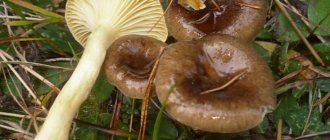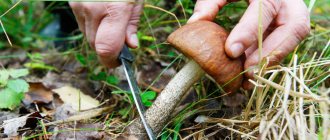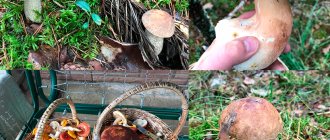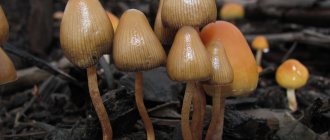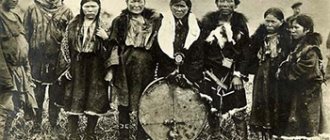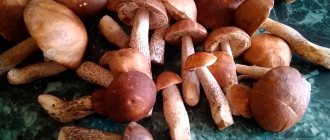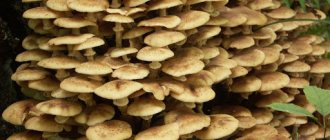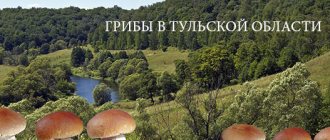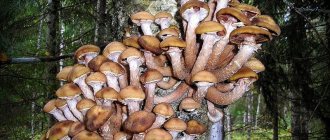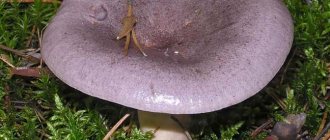Hygrophorus late belongs to the genus of lamellar mushrooms, growing in mixed-type forests and spruce forest plantations among mosses and heather. The Hygrophoraceae family consists of more than 40 varieties, differing in appearance, composition, and fruiting period (spring-autumn). Mushrooms have high nutritional characteristics, and some subspecies have medicinal properties.
What does the mushroom Gigrofor look like?
Useful properties of tinder fungus
The idea of collecting tinder fungi for the purpose of subsequent consumption seems strange only for the first time.
In fact, the name “tinder fungi” includes a huge variety of fungi, of which the woody hoof-like growths on trees are only a minority. In general, the very concept of “tinder fungi” is known to science only indirectly, as something meaningless and amateurish. According to science, tinder is a genus of woody perennial fungus, from which tinder was once made. Everything else is called something else. In the popular concept, a “tinder fungus” is something that grows on a tree and does not look like an ordinary “cap” mushroom. There are also terrestrial polypores (in fact, rather special oyster mushrooms) - the genus Polyporus. They look like tubular ones (and their hymenophore is completely tubular), but the rubbery-inextricable flesh will not allow you to make a mistake. Among the polypore "tinder fungi" there are many edible ones. But first things first.
Cut tinder fungus.
The most popular tinder fungus among people is the sulfur-yellow tinder fungus. People (not ours) call it “witch’s oil,” and for good reason. At the end of May, take a walk through the deciduous forest, look for old oaks and lindens - you will probably see on one or two a lumpy, jelly-like mass of sulfur-yellow color, as if runaway dough. You can see it from afar on the dark trunks of the open oak forest! If found, congratulations; So we met the sulfur-yellow tinder fungus in its edible form. Now all you have to do is take out a knife, cut out the pulp (while it is still pulp), and go home - either to fry, or to salt, or to stuff into pies. A universal mushroom, very valuable in the relative “mushroom-free” conditions of early summer.
Another famous edible tinder fungus is the ram mushroom. (In fact, there are a number of celebrities of this level: Grifola umbelata, the famous “mushroom cabbage” Sparassis crispa.)
Grifola mushroom.
A very interesting, although quite rare, is the “tinder fungus” called the liverwort. In autumn, meat-red tongues of the fungus appear on damaged trunks of linden and oak trees; the physiological sensation intensifies when cut - more meat than mushroom. Drops of red juice that look like blood. It seems as if the tree has sinned deeply in some way and is now being punished by the forest gods. However, this does not stop people from collecting young liverworts and eating them. They write that it is healthy, with vitamins.
Finally, the most “culinary” and widespread genus of tinder fungi is Polyporus. As a rule, these are cap mushrooms with a tubular hymenophore; their edibility is inversely proportional to the degree of hardness of the fruiting body. For example, the “spider,” a scaly tinder fungus that appears in early summer, is relatively soft and therefore edible. Even softer and more edible is the small tuberous tinder fungus, characterized by wide pores. But the May tinder fungus is, in a sense, a transitional form between food and technical tinder fungi. When I get a little bit of it, I crumble it into the soup for flavor. It smells good.
Hygrofor, or sweet mushroom: types and features
The kingdom of mushrooms is vast and diverse. Both edible and poisonous mushrooms are found in nature. Entering the forest during the mushroom season, a simple inexperienced person will not immediately be able to find forest inhabitants hiding under the foliage or at the roots of trees. Some mushrooms are especially popular among mushroom pickers, others can be eaten, but are less popular. Hygrophorus can also be classified as such forest dwellers.
General characteristics of the mushroom
Not everyone has heard of hygrophore, or, as it is also mistakenly called, hydrophore. These mushrooms are quite common both in our forests and in other European countries and even in North America.
Despite its unpopularity, the mushroom has about 40 varieties, most of which are suitable for consumption immediately or after boiling in salt water. Its other name is sweet tooth, as the mushroom has a sweetish taste.
A young hygrophorus mushroom can be distinguished from a more mature one by the characteristic bulge on the cap, which smoothes out over time. Sweets like to grow in meadows and forests, where they grow at the roots of trees - birch, beech, oak, spruce, pine.
This mushroom also loves damp places and an abundance of moss, near which it can also often be found. Hygrophores usually grow in groups, so experts do not recommend collecting individual individuals. Basically, the harvest of sweets begins in August and ends in November, but there is also an early variety that appears from under the snow along with snowdrops and blueberries.
Popular types of hygrophora
A large number of species grow in Russia. The most common are:
- fragrant;
- white;
- beech;
- maiden;
- golden-toothed;
- reddish;
- larch;
- meadow;
- olive;
- late;
- spotted;
- early;
- Russula
Early hygrophorus, or snow mushroom, appears in the forests as the very first of its family. The diameter of its cap can reach 11 cm. It can be found from March to May in deciduous and coniferous forests. Initially, the mushroom is light in color, but then darkens and takes on a dark gray hue. It has no counterparts in nature, since it appears at a time when other edible and poisonous mushrooms are simply absent. Gourmets recommend it for making soups.
Fragrant hygrophorus appears in meadows and at the roots of forest trees in August, along with all its other brothers. The diameter of the mushroom umbrella usually does not exceed 10 cm, and the color is light at the edge, darkening towards the center of the cap. The strong almond smell that a growing individual exudes gives it its name, since in wet weather this member of the family can be found by its aroma alone. You can enjoy it from August to early October.
Hygrophorus alba is also called the ivory mushroom. The diameter of the cap of this representative of the family reaches 8 cm, it is covered with a thick layer of mucus. It appears in early September, but despite the fact that it creates large colonies, is common and edible, it is not in great demand among mushroom pickers.
False doubles
During late autumn there are no dangerous false representatives as such. The olive white hygrophorus has only one poisonous fellow - the white grebe. At a young age, when the sweet cap is not yet deformed and has a bell shape, it is very similar to an early toadstool, so mushroom pickers often avoid the species. However, during the collection period, which usually falls at the end of October, the false double no longer grows, so even a beginner can collect hygrophores. The difference can be seen in the photo. It is worth highlighting separately the hymenophore, which in the sweet tooth extends directly to the stalk and has more pronounced plates.
False doubles:
- Maiden Hygrofor - grows in clearings, similar in shape, but has red spots all over the body. In taste and smell, the mushroom differs from the sweet mushroom only in shades; in the false mushroom it is weak and barely noticeable, and the flesh is dry.
Hygrofor girlish - Fragrant Hygrophorus - this species can rarely be found in the forest. It usually chooses rocky terrain and grows mainly in spruce forests. It smells like almonds and can be eaten.
Fragrant hygrophor
For comparison, you should pay attention to the photo. Mushrooms, if you look closely, have obvious differences in shape. If a lover of quiet hunting confuses species of the same family, there will be nothing wrong with that. Representatives are edible and not dangerous.
First mushrooms of the year
The mushroom picking season in Belarus begins early: already in April-May. The first rays of the gentle spring sun begin to warm, the trunks of birch trees are filled with sap. It is at this time that the first harvest of mushrooms can be harvested. What mushrooms grow in Belarus in early spring? These are morels and lines. When the birch buds swell and turn red, and the aspen earrings fluff up, you can safely look for “snowdrop” mushrooms in the forest. They grow on the slopes of ravines, forest clearings and clearings, old burnt areas and abandoned forest roads. The stitches are brown in color and are soft and velvety to the touch.
Their smell is pleasant. Their shape is squat, the top of the cap is folded. Morels are olive-brown in color and have sharp-shaped caps. Mushrooms of Belarus of the early period have such forms for a reason. The design helps to absorb more heat and the first sunlight.
Mushroom Hygrofor description.
The name hygrophorus unites a numerous genus of lamellar mushrooms, which are part of the Hygroforaceae family. Mushrooms are common almost all over the world, but they are not considered edible everywhere. About 10 different species grow in our latitudes, including both edible and inedible. The peculiarity of the genus Hygrophora is that almost all varieties have small fruiting bodies with convex mucous caps. Let's look at descriptions of edible species.
- Snow-white hygrophor.
Tiny mushrooms that are common in meadows and deciduous forest areas. Due to their small size, they are difficult to notice, so the “prey” goes to only the most attentive mushroom pickers. The cap of the snow-white hygrophorus is small, reaching a maximum diameter of 3 cm. In young mushrooms, the cap has a hemispherical, convex shape, but with age it noticeably flattens and can become funnel-shaped. In young mushrooms, the color of the cap is white; with age, it acquires a cream or beige hue.
With high humidity, the surface of the caps becomes slimy. A distinctive characteristic is thin and sparse descending plates. The leg grows from 3 to 6 cm in height. The leg is painted in the same shade as the cap. When cut, the pulp is snow-white, with a weak aroma and very thin, almost tasteless. Snow-white hygrophorus belongs to the fourth category of edible mushrooms; it can be consumed only after soaking and heat treatment.
- Russula hygrophor.
Another edible species from the genus Hygrophorus. Most often, this mushroom can be found in coniferous forests and birch groves, but not earlier than mid-September, and no later than the end of November. Russula hygrophor has a rich taste and a light mushroom aroma; its flesh is white, does not change color during oxidation, but is slightly bitter, so it is soaked before cooking to get rid of the bitter taste.
Pinkish caps can grow from 2 to 9-10 cm, have a hemispherical, convex shape, but over time they become flat and prostrate. Small scales are observed on the surface of the cap closer to the center. The leg is thin, erect or curved, up to 10 cm in height, closer to the cap it is covered with small scales, and at the base it is colored beige. The plates of the mushroom are thick, descending onto the stalk.
- Hygrophor brown.
This mushroom should be looked for in damp, dark and mossy places in coniferous and mixed forests, and it is considered one of the latest, since it begins to bear fruit only in early October. The mushroom caps are depressed in the center, medium-sized - maximum about 5-6 cm in diameter. The surface of the cap is covered with thin, sticky, brown or brown-olive skin, which is slightly lighter at the edges.
Thick, waxy plates are yellow in color, descend onto the stalk and are sparsely located. The legs are thin, up to 1 cm in diameter, long – up to 10 cm, cylindrical in shape. The leg can be colored beige or olive-brown, slimy, with a barely noticeable membranous ring - the remains of a veil. Brown hygrophorus is good for salting and pickling, and can be consumed boiled.
- Olive-brown hygrophor.
An edible and tasty hygrophora, found mainly in coniferous forests. The fruiting season begins in August and ends with the first frost. The legs of this mushroom are white or brown or light olive, covered with ring-shaped scales of a darker shade. The caps can grow up to 10 cm in diameter, are slimy and sticky, and have a glossy shine in dry weather. The color of the cap is light olive, the shade becomes more saturated closer to the center, and lighter at the edges.
Use in cooking
Hygrophores have a delicate taste. Before cooking, be sure to remove mucus.
In world culinary practice, hygrophores are quite popular, unlike in Russia. When using them, it should be taken into account that mucus on the surface of the cap, remaining even in the smallest amount, can completely ruin the taste of the dish. Therefore, it must be cleaned very carefully. For your information. Unlike many other edible species, hygrophores boil down much less.
They are used for pickling, pickling, boiling and frying.
Cabbage and mushroom pie
For preparation you will need:
- 250 g minced meat;
- 200 g mushrooms;
- 700 g cabbage;
- 2 onions;
- 4 eggs;
- 50 g flour;
- sunflower oil;
- greenery;
- salt and ground black pepper to taste.
Mushrooms are washed, peeled, and boiled for 15-20 minutes in salted water. The onion is chopped, fried until golden brown, mixed with minced meat, mushrooms, salt, and spices. The cabbage is chopped finely, eggs, flour, herbs, and salt are added to it. Place half the cabbage in the pan, mushroom filling on top, then the rest of the cabbage. The pie is fried on both sides until cooked. Before serving, you can decorate with herbs.
Mushroom gratin
To prepare mushroom gratin you will need:
- 1 kg of potatoes;
- 500 g mushrooms;
- 250 g heavy cream;
- 2 eggs;
- 1 onion;
- 20 g mayonnaise;
- 2-3 cloves of garlic;
- salt, spices to taste.
Mushrooms are cleaned, washed, fried with onions. The potatoes are cut into small pieces, then placed in an even layer on the bottom of the baking dish. A mushroom filling is placed on top (evenly over the entire surface of the potato). The filling is made - cream, eggs, garlic, salt, spices, and mayonnaise are mixed. It is poured over gratin. In the oven, the dish is baked at 180℃ for 60 minutes. Serve cut into portions.
Terms and rules of collection
As a rule, the mushroom season begins in late summer or autumn, but some types of agaric mushrooms can be harvested even in June. For example, russula and champignons appear already at the beginning of summer, and their collection can last until the end of autumn.
There are also cap-shaped plate species that are found even in winter. A striking example is the winter honey fungus. It's hard to find, but it grows in large clumps, so you can pick up a whole basket at a time. Butterfly is also considered a valuable representative of the species, which also grows in large groups and is very tasty when salted and pickled.
In general, we can say that edible agaric mushrooms are those species that can be collected in any forest throughout the warm season.
The video contains names, photos and descriptions of the best agaric mushrooms.
Wild mushrooms - interesting facts.
White mushroom or boletus
The name “white” for this king of mushrooms did not appear by chance: the flesh of the mushroom does not darken when cut, and after heat treatment and drying it acquires a pronounced white color.
Boletus is great for boiling, frying, drying, and pickling. Rich in proteins, which are best (80%) absorbed from dried mushrooms.
Be careful not to confuse the boletus mushroom with its inedible counterpart, the gall mushroom. The latter immediately darkens when cut, has a bitter taste and a pink tint to the sponge under the cap.
Milk mushrooms
Milk mushrooms usually grow in large families or “piles,” hence their name. Milk mushrooms prefer low temperatures and are collected at the end of summer - beginning of autumn.
Before eating, milk mushrooms should be soaked in salt water for a long time, changing it several times to remove the bitter taste. Then the milk mushrooms are boiled and salted. There's a lot of hassle with them, but it's worth it.
In the old days, milk mushrooms were salted in barrels: crispy salted mushrooms and pies with milk mushroom filling were the favorite delicacy of our ancestors.
Chanterelles
Chanterelles owe their name to the characteristic light yellow or deep orange color of these mushrooms, which resembles the color of a fox. They can be collected from early summer to late autumn.
Thanks to the substance chitinmannose, a natural antibiotic and anthelmintic, these mushrooms never contain worms or other parasites.
Chanterelles can be fried, salted and pickled, but you should not dry them - losing water, their flesh becomes “rubbery” over time and is impossible to eat.
Butter
Butterflies get their name from their oily, slippery brown caps. They grow in coniferous forests, on sandy and calcareous soils. They love edges well lit by the sun.
Butter is considered an aphrodisiac and gives a person vigor and strength. The skin of the mushroom contains strong natural antibiotics, so it is best not to remove it when cleaning. Butter is boiled, fried, pickled.
Honey mushrooms
Honey mushrooms most often grow on stumps in large families. Fans of honey mushrooms should be careful to distinguish them from their false, inedible “brothers.” The latter have a brighter, more saturated color of the cap, under which there are no scales and a skirt, characteristic of true mushrooms.
Honey mushrooms are great for pickling, preparing hot dishes and cold mushroom appetizers.
boletus
It grows under birch trees, or more precisely, in their roots (sometimes in the roots of aspen and poplar). The mushroom ripens very quickly and also ages quickly - it becomes dark and wet. So, having collected boletus mushrooms, cleaning and cooking them should not be put off until tomorrow.
Dietary fiber from boletus can remove toxins from the body, and this mushroom also has a beneficial effect on kidney function.
Boletus
Boletus or redhead grows in aspen thickets, hence the name. The aspen boletus, like the porcini mushroom, can be confused with the gall mushroom (gorchak), which is characterized by a bitter taste, a mesh pattern on the stem and the ability to turn pink when cut (the aspen boletus darkens or turns blue).
This mushroom can be eaten in any form (fry, boil, salt, pickle), and in order to prevent it from darkening during cooking, it is first soaked in a 0.5% solution of citric acid.
Ryzhik
Camelina occupies a leading place among mushrooms in terms of taste and nutritional qualities. Red camelina contains a unique substance, the natural antibiotic lactarioviolin, which inhibits the growth of Koch's bacillus, which causes tuberculosis, in the human body.
Before eating, you don’t have to soak the saffron milk caps; just clean the caps of debris by wiping them with a damp cloth, then pour boiling water over them. Saffron milk caps are salted, pickled, boiled and fried, and dried.
Russula
Russula is perhaps the most common of the mushrooms. It has many varieties, among which there are both edible, some can even be eaten raw, and poisonous. If you have doubts about a mushroom, it is better not to take it.
Fresh russula extract has remarkable antiparasitic properties. Traditional medicine has long used russula as an effective diuretic. Usually, before use, russulas are well soaked, then boiled, stewed, fried, or salted for the winter; they are usually not used for drying.
Evaluation of taste qualities, medicinal properties, benefits and possible harm
The main feature of the sweet tooth is its sweet and pronounced mushroom taste. This is the only representative of Hygrophores that can boast of such a characteristic, despite its size. Often used by housewives for making pickles or roasts. It can cause harm to the digestive tract only in the case of severe overeating, but during the entire practice there are only a few such episodes.
The mushroom is not officially used in pharmacology, but the sweet tooth has the prospect of becoming a source of a new type of antibiotics. Main advantages:
- Has an antifungal effect.
- A good antibacterial remedy for colds.
- Has secondary metabolites.
Today, scientists are actively studying the blackhead. Perhaps in the future the Hygrophora family will be used to produce antibiotics to treat influenza and other viruses.
REFERENCE! In folk medicine, decoctions of dried and dried mushrooms are often prepared. The broth will help get rid of a lingering cold and restore vitality. In the north, sweets are used to prevent various infections.
Preparation
The harvested meadow mushrooms must be cleared of insects, grass and soil residues. The sticky cap in wet weather attracts a large amount of debris, so the mushroom harvest can be quite dirty. Worthy and old specimens must be disposed of immediately. You should also remove the stem ring as it can give the product a sour taste and ruin its flavor when cooked. Fruit bodies that will be dried should not be soaked in water. Soaking will increase the drying time, and can also create unpleasant consequences in the form of rotting of the pulp during heat treatment. It is enough to rinse the meadow grass well, wipe it with a cloth and you can begin the dehydration process.
If meadow honey mushrooms are planned to be pickled or simply eaten, then soaking is a mandatory procedure. After thorough washing, you need to soak the mushrooms for several hours, changing the water at least 3 times. Next, pour clean water over the meadows and bring to a boil. After boiling, reduce heat and simmer for 15 minutes. Drain the finished broth and fill it with clean water. Boil for about 15 minutes and drain. Despite the quick cooking, the mushrooms have time to cook and are free of impurities. Next, the meadows are used in accordance with the recipe.
Edible species of hygrophorus mushrooms
The Hygrophoraceae family contains about forty species, the most popular of which are aromatic, black, fragrant, oak, spruce, as well as early, deciduous, and russula.
Hygrofor early
The name of this species was given for a reason: the first fruits begin to appear as soon as the snow melts from the ground. The mycelium is located in thickets of coniferous trees, hiding in the thickness of old needles. In mixed forests you can find the fungus in fallen leaves. It grows in groups and has no duplicates.
The cap of the early hygrophore is white, convex in shape with a slight bend along the edge. The flesh is also white and the stem is short and thick. It has a pleasant mushroom aroma and taste, suitable for preparing first courses.
Hygrophorus late
This species is represented by small-sized fruits with a cap diameter of up to five centimeters. Appears in coniferous and mixed forests in mid-September and bears fruit before the onset of severe cold. The mycelium is located so that mushrooms can be collected in whole groups,
finding fruits in thickets of moss or last year's leaves. The cap is brown and covered with mucus. The pulp is very tender, and the fruit itself is very fragile, which is why it needs to be collected in a solid container. The leg is long, thin, and also covered with mucus.
Hygrophorus blushing
Another name for the mushroom is reddened or reddish hygrophor. The fruit cap is small in size and white or pink in color. In a mature species, it evens out a little and becomes covered with yellow spots.
You can find this species in coniferous and mixed forests in August or September
. Can be adjacent to spruce and pine. It does not have the smell or taste characteristic of the Hygrophoraceae family. The closest “relative” is the Russula hygrophorus.
Hygrofor olive-white
The leg of this species has a regular cylindrical shape and is quite thin. Covered completely with mucus and sticky to the touch. The plates are wide and are a continuation of the legs. The cap is small, brown in color with green veins. Fruits from late summer until autumn,
found in mixed forests adjacent to pine and spruce trees.
Golden hygrophor
This type of mushroom has a convex cap with a bumpy surface. In young fruits, the edges are slightly bent inward. The skin is smooth, slightly sticky, covered with small scales. The plates below are wide and sparse.
The pulp is white, has no foreign odor with a barely distinguishable taste.
Combines with other mushrooms and grows in coniferous and deciduous forests under oak trees and on hills. The ripening period is August-October.
Hygrophorus spotted
The spotted hygrophobe has a small hat - about three centimeters, convex in shape, slightly concave towards the center. In young fruits it is covered with small scales. When the air humidity is high, mucus appears on the skin, and the mushroom may look a little lighter than it is. The flesh of the mushroom is white, fragile, and has no smell or taste.
Spotted hygrophobe is common in conifers
, since the moth grows only in symbiosis with spruce. It bears fruit in groups, the ripening season begins at the end of September and lasts about two months.
Hygrophorus snow-white
The species is represented by small fruits with a convex cap with a diameter of about three centimeters. In mature mushrooms it is pressed inward and has a wavy edge. In this case, rare and wide white plates appear. The leg is cylindrical, smooth, slightly expanding upward. It is about 4 millimeters thick and contains transparent spores. The mushroom is completely edible
grows in meadows and grass thickets.
Hygrofor black
Black hygrophorus is a delicious mushroom and is often found in places where moss grows and dampness appears. Most often it can be found in Southern Finland. The hat is wide, has a dry and smooth surface, with terry around the edges. It reaches 12 cm in diameter. It is located on a cylindrical stalk, slightly narrowed at the base. The wide plates are sparsely spaced and have a white or bluish color. Fruits in the autumn.
Fragrant (fragrant)
An edible mushroom with a strong odor, which gives rise to its name. The cap of the fragrant hygrophorus is medium in size (no more than ten centimeters in diameter). It is painted brownish or gray, and the edges are usually lighter than the center. The surface is smooth or slightly sticky. Young mushrooms have convex caps, but over time they become flat.
The gray leg is from four to twelve centimeters high, noticeably lighter than the cap. It has a cylindrical shape. There are specimens with flattened legs covered with scales along their entire length. The flesh of this mushroom is gray or white, sometimes has an olive tint. It is soft and crumbly, slightly watery. The strong almond smell, which gives the mushroom its name, can be felt in damp weather if you are a meter away from the mushroom. This hygrophore can often be found in the Far East from the end of August until the first days of October in pine-spruce forests on calcareous soils. Occasionally found near firs. It has an excellent taste when salted and pickled.
Preparation and storage
It is recommended to harvest only young mushrooms with a dense body, without signs of spoilage or mold on the surface. At home, sort immediately and store in the refrigerator for no more than two days.
Hygrophores can be stored frozen (pre-boiled, packaged in portioned bags) or salted. To pickle mushrooms, it is recommended to put them in a barrel, sprinkle each layer with salt and spices, and fill with chilled boiled water. Place the pressure, after a week put it in glass jars, fill with the resulting brine.
Growing at home and in the country
If you manage to purchase mycelium powder in a specialized store, you will be able to grow these wonderful mushrooms yourself. Step-by-step instructions for beginner mushroom pickers:
- Mix the mycelium with dry sand or forest soil.
- Prepare a bed in a shaded corner of the garden - loosen the top layer of soil by about 15 cm.
- Sprinkle the prepared bed evenly with a mixture of mycelium and sand, cover with a thick layer of substrate (garden or forest soil mixed with compost).
- Water the future mycelium generously.
Having studied the taste, beneficial properties and description of the mushroom, you can safely go into the forest. These representatives are found everywhere, are distinguished by increased endurance, and even in dry weather they will be able to return from the forest with a rich “harvest.” If you don’t have time for mushroom forays, it doesn’t matter - you can grow hygrophores even at home - they are unpretentious and will delight you with a generous harvest soon after planting.
Growing methods
Hygrofor can be grown at home by sowing mycelium. One package goes for 1 m². The “seeds” are mixed with soil or sand. Planting is carried out under trees in any warm season (spring-autumn); the soil requires digging and loosening to prepare planting holes.
The mycelium is placed on a loosened area and covered with a layer of forest or garden soil. The planting is watered at the rate of 10 l/m². Harvesting is carried out 4 times a year: 2 times in spring and autumn. It is possible to improve the planting yield with the help of fertilizers with humus, but not during the growth period.
Hygrophores can also be grown indoors, but the yield with this method of growing this mushroom is low.
